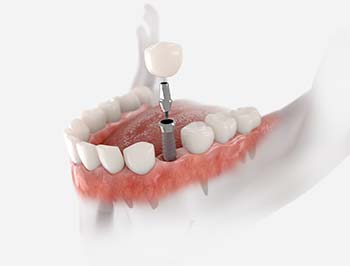We get two sets of natural teeth in our lifetime: primary and permanent. The primary teeth begin to erupt around 6 months of age. By the time a child has reached the age of 13, most of their primary teeth have fallen out and been replaced by permanent teeth- which should last a lifetime.
Unfortunately, things happen that cause tooth loss in adults. The cause could be genetic or could be due to poor oral hygiene habits, health conditions, lifestyle habits, and more. For many years, conventional dentures and bridges were the only options for tooth replacement. In 1965, dental implants were introduced.
A dental implant is an effective solution for missing teeth and may be used to replace a single tooth or as a support for dentures or dental bridges.

- Implant: inserted into the jawbone and acts as an artificial tooth root
- Abutment: connects the implant to the crown
- Crown: a prosthetic tooth that sits on the gum
After an implant is placed, the jawbone heals around and fuses with it making it a permanent fixture in your mouth. According to experts, implants have a 90% to 95% success rate over 10 years. This means that there is a 5% to 10% risk that the implant will fail due to several factors.
If you are missing teeth and considering dental implants, schedule your consultation with Dr. Alan Jureidini or Dr. Ramy Habib at Arlington Dental Excellence today. Here is what you need to know about how long dental implants last and what influences implant failure.
Dental Implant Life Expectancy
After implants are placed, the jawbone heals around and fuses with it, making it a permanent fixture in your mouth. This process is known as osseointegration and creates a stable foundation for a prosthetic tooth.
However, while the implant is designed to be permanent, research shows that approximately 50% to 80% of crowns need to be replaced within 15 to 20 years.
Common Causes of Implant Failure
According to research, 5% to 10% of dental implants fail. Implant failure is typically due to interference with osseointegration or the healing process, including:
- Improper care/maintenance: implants require the same oral hygiene as your natural teeth.
- Insufficient bone density: implants rely on your jawbone for support. Patients with inadequate bone density may opt for additional procedures such as bone grafting.
- Smoking: patients who smoke are at a higher risk of implant failure (11%) than non-smokers (5%)
- Teeth grinding: grinding can cause the implant to shift, which interferes with healing
- Medical conditions: patients with certain medical conditions are at a higher risk of implant failure. These conditions include: uncontrolled diabetes, a weak immune system, cardiovascular disorders, osteoporosis, and bleeding disorders.
- Age: older patients are at a higher risk of implant failure because they are more likely to have underlying conditions and healing is typically slower.
- Medications/Treatments: patients who have undergone or are currently undergoing radiation therapy/chemo or are taking blood thinners are immunosuppressive medications are at a higher risk of failure.
Symptoms of Implant Failure
Some of the signs and symptoms of implant failure include:
- Implant that moves
- Pain, especially when biting/chewing
- Pus/discharge
- Redness
- Bleeding
- Swelling
- Receding gums
How is a Failed Implant Treated?
The first thing we will do is assess your condition. In many cases, a failed implant needs to be removed to prevent further damage. This is typically done under local anesthesia. In some cases, the implant can be replaced. Research indicates that placing a new implant after failure has a 71% success rate.
If bone loss has occurred, a bone graft may be required before a new implant can be placed. You will need time to heal after this procedure, so it may be a few months before a new implant can be placed.
If the implant cannot be replaced or if you choose not to replace it, you do have other options. Arlington Dental Excellence also offers dentures or dental bridges.
In some cases, as long as significant bone loss hasn’t occurred, peri-implantitis can be treated without implant removal. This process involves a course of antibiotics, along with thoroughly cleaning and decontaminating the implant and the area around it.
Conclusion
Dental implants are designed to be a permanent solution for patients who are missing one or more teeth. This is because after implants are placed, the jawbone heals around and fuses with the implant to secure it in place through a process known as osseointegration.
Implants have a 90% to 95% success rate. However, this also means that there is a 5% to 10% chance that the implants will fail. There are several things that can cause implant failure.
In some cases, failed implants can be replaced. However, replacement is not always an option. If you are experiencing signs and symptoms of implant failure or you are missing teeth and want to learn more about dental implants, schedule an appointment with the team at Arlington Dental Excellence. We have two certified Implantologists on staff: Dr. Alan Jureidini and Dr. Ramy Habib. We have the experience and expertise to guide you through the process.




